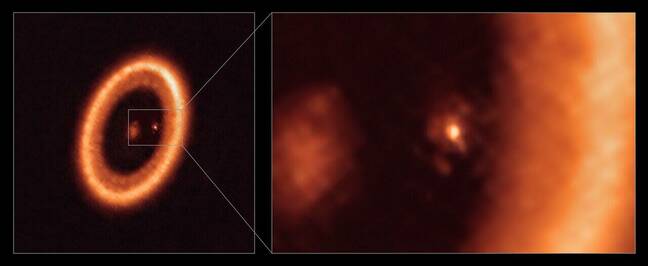Pic Astronomers have for the first time spotted what appears to be a moon-forming ring of matter around a young exoplanet, and described their findings in a paper published on Thursday.
Orbiting a star 400 light-years away, PDS 70c is an otherworldly Jupiter-like gas giant that is particularly interesting to planet watchers. Unlike most other confirmed exoplanets, PDS 70c and its neighbor PDS 70b are not yet fully grown. So much so, when they were discovered in 2018 and 2019 respectively, it was the first time researchers were able to directly image a protoplanet.
The latest observations have confirmed PDS 70c is harboring another astronomical gem: it’s surrounded by a cloud of gas and dust in which satellites are slowly taking shape.
“Our work presents a clear detection of a disc in which satellites could be forming,” said Myriam Benisty, first author of the paper and a researcher at the University of Grenoble, France.

Left: Image taken by the ALMA telescope of the system surrounding the central PDS 70 star. The bright rings are where the planets, PDS 70b and PDS 70c are forming. Right: Close-up of the bright spot: the moon-forming disk around PDS 70c. Image Credit: ALMA (ESO/NAOJ/NRAO)/Benisty et al. Click to enlarge
Back in 2019, Benisty and her colleagues suspected they had glimpsed the fuzzy outline of a circumplanetary disk around the exoplanet. Now, they are sure of it after being able to see it more clearly with the ALMA telescope in the Chilean desert.
“Our ALMA observations were obtained at such exquisite resolution that we could clearly identify that the disc is associated with the planet and we are able to constrain its size for the first time,” she said.
The moon-forming disk measures about the same distance from our Sun to Earth in diameter, and holds enough mass to form up to three satellites the size of the Moon. It’s not clear how many moons will eventually orbit PDS 70c, however.
Astronomers believe that satellites are created in a similar way to planets. Particles of gas and dust collide and glom together to form an accretion disk that steadily gets bigger in size. The evidence for these so-called circumstellar disks, where planets are born, have been spotted around stars, but circumplanetary disks, where moons are born, have rarely been seen.
“These observations are really the first where we’ve been able to truly identify the presence of a circumplanetary disk — until now we didn’t have definitive proof that these exist,” co-author Richard Teague, a fellow at the Harvard & Smithsonian’s Center for Astrophysics, told El Reg.
“Beyond that, we can measure the size and mass of the disk, providing clues on the internal structure and the likelihood of this disk in forming moons. Additionally, as we have such wonderful data on the circumstellar disk, we can put all of these constraints in the context of the larger circumstellar disk to understand whether the environment is similar to those which theories would predict are most likely to form circumplanetary disks.”
The researchers reckon that both exoplanets, PDS 70c and PDS 70b, provide good environments to study the necessary conditions for moons to form.
“One of this big puzzles in this system is the difference between the two planets. Both planets have been detected in the near infrared, however only PDS 70c seems to have a clear circumplanetary disk around it. We want to better understand the difference between these two planets,” Teague added.
“Is PDS 70c starving PDS 70b, for example? Could it be accreting all the material from the circumstellar disk before PDS 70b has a chance? Having the opportunity to study one example of a moon forming disk is great, but [the planetary system] is unique in that it allows us to study two, and the interplay between them.” ®
Article From & Read More ( We've seen things you people wouldn't believe. An exoplanet building its own moons - The Register )https://ift.tt/3iJ6fGK
Science
No comments:
Post a Comment